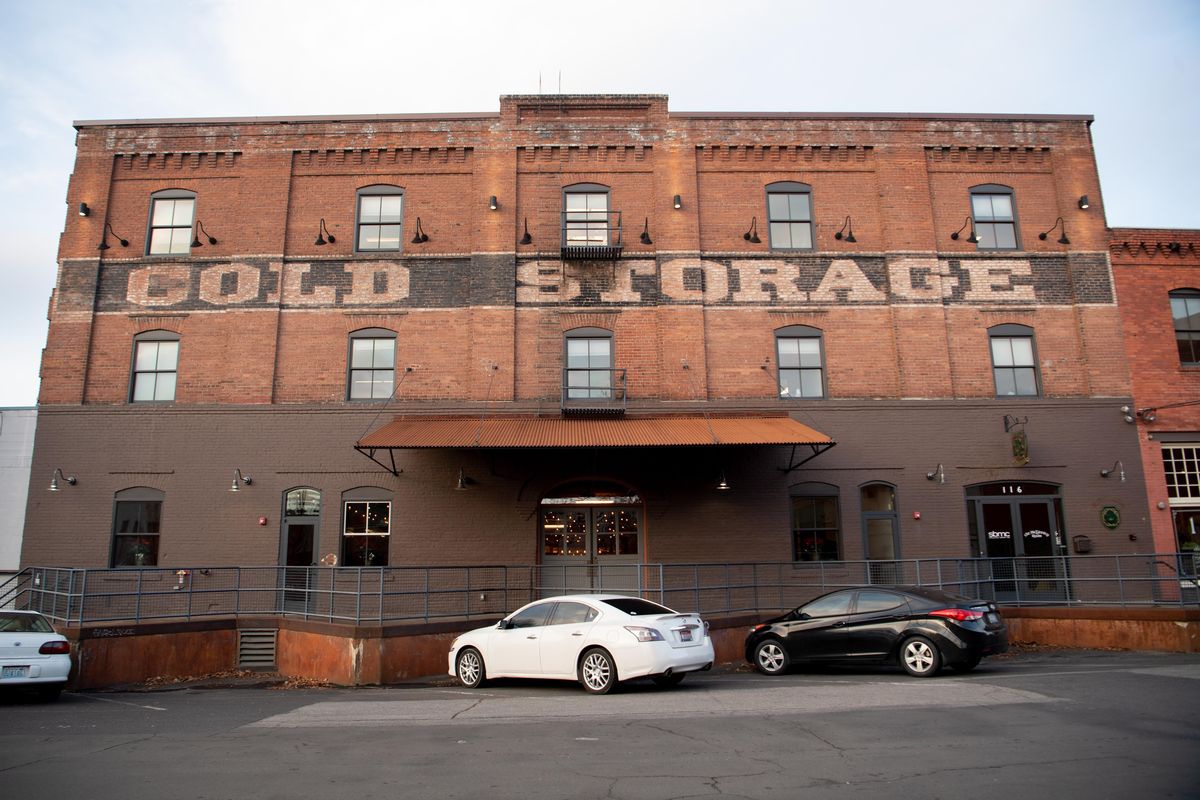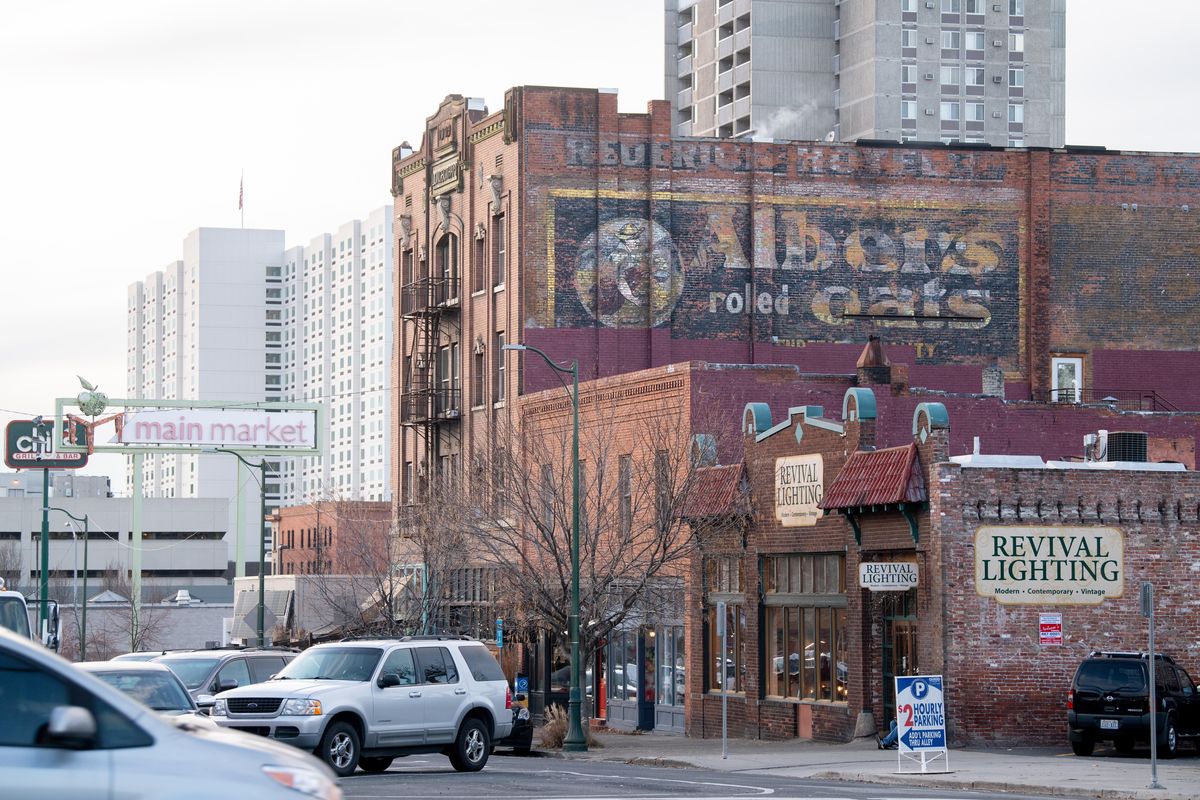Shawn Vestal: Depths of Spokane history lie beneath fading downtown ghost signs
Cigars are advertised in downtown Spokane on the side of the old building, shown Monday, Nov. 21, 2019. Such advertisements, called “ghost signs”, harken back to early Spokane. (Jesse Tinsley / The Spokesman-Review)
They hover in the air all around us – the pale specters of Spokane’s history, rendered in lead paint that is fading but seemingly eternal.
Albers Rolled Oats. Snowflake Crackers. Columbus Buggy Company.
Our city’s historic brick buildings wear the faded history of painted advertisements all around downtown. The more you look, the more you see. Most are the remnants of a particular era of advertising in the city, around the turn of the last century when brick construction of taller urban buildings were used as blank slates for marketing purposes, to appeal to a generation of single men who were flocking to Spokane to work on the railroads and in the mines.
Henry George Cigars. J&D Paints. Rex Flour.
A good deal of the advertising remains on buildings that were among the most prominent structures built following the Great Spokane Fire of 1889. They also flourished – and remain most noticeable to this day – in the West Main stretch of downtown that was, a century ago, the place where single men rented single rooms. Now the signs are a key part of the character of one of the city’s thriving downtown blocks.
What’s on the surface is interesting, and adds character to the downtown landscape. But beneath the surface of the advertisements lay depths of Spokane history. If you look beneath the surface of a faint old paint company sign you’ll find the story of the prominent druggist who ran for office and wound up punching out a newspaper reporter on the House floor. The sign for one of the oldest auto dealers in town still bears the sign of the company that painted it – a firm owned by a man who came to Spokane from South Africa.
Anna Harbine is Spokane’s leading expert on the ghost signs. She began researching them as a history student at Eastern Washington University, as part of a project that’s online at spokanehistorical.org. She’s now the Johnson-Fix Curator of Archives and Special Collections at the Northwest Museum of Arts and Culture and gives annual walking tours of the signs.
She says part of the appeal of the signs for her is that they point to parts of Spokane’s history that might be less well-known than the big-name, fathers-of-the-city stories that are most familiar. They are remnants of Spokane’s working-class roots, of the rough-and-tumble side of the prosperity the city enjoyed in those years.
“I like that they’re still here in a way that’s not on a tombstone,” Harbine said in an interview this week.
The signs cluster most prominently around the first block of West Main, the district that includes the Saranac and Community buildings, and the Longbotham Building, among others. The block is ground zero for Spokane ghost signs, with an incredible range of old ads remaining – to varying degrees – on the sides of several buildings.
It’s also the home of the best-preserved sign in Spokane: the huge Bull Durham advertisement that’s now on the inside wall of Boots Bakery Lounge. The wall was formerly an exterior wall, before the Longbotham was built next to it. When the building was being renovated by owner Dan Spalding, the Bull Durham was revealed, and Boots kept it.
“This is the best-preserved sign in the city,” Harbine said, pointing to the Boots wall, “because it’s been hidden behind plaster.”
It’s hidden no more. Unlike the exterior signs, the Bull Durham sign retains vivid colors. It covers a large portion of the wall at Boots, and includes a signature from Thomas Cusack, a Chicago-based artist who traveled the country painting similar ads.
Here is a series some of the more prominent fading ads, based in large part on the research done by Harbine and her former fellow EWU students and posted at the Spokane Historical web site, as well as newspaper accounts and other historical sources.

Frederick/Longbotham building
22 W. Main Ave.
Inside and out, the Frederick/Longbotham Building is a virtual museum of historic Spokane advertisements. Originally a “single-room occupancy” establishment that opened in 1910, the Frederick Hotel sign is still visible on several sides of the building at the top.
It was one of several SROs serving miners, railroad workers and other laborers. Like others, it relied on a mixed-use model before that became an urban planning buzzword: with 57 rooms for rent on the upper floors and retail/business space at street level.
It was also one of many businesses owned by Japanese-Americans in downtown Spokane. That part of town was one of the few places where people of color and immigrants might do business in Spokane then, and their history is threaded through the stories of the signs.
The Frederick was sold and renamed the Lewis Hotel in the 1930s, after new owner Lewis Longbotham.
The Bull Durham ad on the inside of Boots Bakery Lounge is the brightest, most vivid sign in town, thanks to the fact that it was under plaster for many years and is now indoors.
But the exterior of the building has several signs, as well. Ads for Albers Rolled Oats and Rex Flour – “Rex Is King” – remain on the building’s exterior. The Rex Flour sign on the north side was painted over an earlier tobacco sign, a small part of which remains visible. The vast Albers Rolled Oats sign on the east side represented a company that had mills in Tacoma, Portland, Seattle and San Francisco.

Washington Cracker Company
304 W. Pacific Ave.
This building – now a center of arts and cultural events, as well as the Hogwash Whiskey Den – was once a fortress in a regional “cracker war” at the turn of the century. At the time around 60 people worked for Washington Cracker, which had recently been acquired by the Pacific Coast Biscuit Company and made part of a corporate trust. What followed was a trade war between that “cracker trust” and the Inland Cracker Company, which had been founded by a former Washington Cracker worker. The trust war artificially kept cracker prices low – and was a bitterly fought political battle – until both sides declared amnesty and raised the price of a box of crackers from a nickel to a dime. Gazing upon the building from the north side, across the railroad tracks, is the iconic “Snowflake Saltines” ad on the horizon.

Broadview Dairy
411 W. Cataldo Ave.
A neat, well-maintained remnant of Spokane’s days as a dairy boom town. Founded by Allen H. Flood, who once ran the largest herd of dairy cows west of the Rockies in Rosalia, and his sons, the four-story Broadview Dairy was the largest in the state, producing milk and other products from more than 20 regional dairy farms. Broadview flourished – in part due to aggressive marketing that included advertising that suggested their competitors’ cows had tuberculosis – and the four-story warehouse and production center was built in 1910. It housed delivery wagons, hay storage, and ice-cream making and pasteurization equipment and supplies.

Globe Hotel
204 N. Division St.
Boasting hot and cold water in every room, the Globe was another SRO serving working people. It opened in 1908, and owner Henry Sorg named it the “Janet Block” after his wife. Some of the rooms offered the luxuries of closets and private bathrooms. While the interior of the building has been renovated, and the marquee sign out front is a replica, an original painted sign on the back of the building remains, touting rooms for 75 cents and up, steam heat and other amenities.

J&D Paints
1722 W. Broadway Ave.
A faint remnant of a different era for the West Central neighborhood. This sign adorns a building that once also housed Broadway Pharmacy, owned by the colorful Canadian-born druggist James W. McArthur. In the early 1900s, West Central was being platted and developed as a neighborhood for the growing middle class. A part of a neighborhood commercial district, McArthur’s pharmacy also sold other dry goods, served as post office and was a site for voter registration. McArthur himself served in the state Legislature, and once gained notoriety for punching a Spokesman-Review reporter (yielding to an impulse that must be common among at least some elected officials).

F.A. Williams Pioneer Ford
Post Street and Second Avenue
Touting one of the earliest auto dealers in Spokane, this sign has another historical claim: It seems to be the only remaining sign by the U.S. Sign Company, a business founded by Aubrey Lorraine in 1917. Lorraine was a native of South Africa who came to the U.S. in 1916 and became a business owner living on the South Hill. Pioneer Ford ran a dealership on First Avenue and had a warehouse on Railroad Avenue.


Hotel Saranac
25 W. Main Ave.
Another SRO on West Main, the Saranac Building, along with other neighboring buildings involved in the Community Building cluster of projects on West Main undertaken by Jim Sheehan, exhibits a wide range of old advertisements in different stages of repair. The Hotel Saranac sign itself is still banded across the eastern top of the building, a remnant of the era when workers flooded the neighborhood.
The west side of the Community Building, two doors down, includes a large Coca-Cola sign, a “Ketchum & Sons Wholesale Goods” and several other remnants. Harbine, the ghost sign expert, discovered a relatively new sign on the alley side of that block – a large coffee ad that reads “MJB The Quality Coffee of America WHY?” The Saranac, originally opened by the Hutton family, was sold to Norboru Hayashi in 1947 – one of several businesses that were bought by Japanese-American families in the neighborhood after World War II.

Rasher & Kingman Vehicles
118 S. Lincoln St.
A few important signs are visible on the site of the former local dealership of the Columbus Buggy Company. The local dealers were Rasher and Kingman, a pair of Spokane businessmen with a variety of interests at the time. On the north-facing wall of the building is a hard-to-read remainder of a Columbus Buggy sign and another for Child Bros. & Day – an agricultural equipment dealer owned by a prominent Spokane family with involvement in business and politics. On the west side, clearer, is a sign reading, “Rasher & Kingman Vehicles of All Kings, Schuttler Wagons.”

Henry George Cigars
27 W. Main Ave.
In another era of great income disparities, Henry George became well-known as an economist and author who wrote about in inequality – and as the namesake for nickel cigars. This was one of two signs in Spokane, though the other has been painted over. The sign first adorned a building owned by Bernard and Eva Endleman, German Jews who immigrated to Spokane from Russia and went into business, opening Spokane Junk Metals, a successful business adjacent to the rail yards for decades. The Endlemans were part of a thriving Jewish community in Spokane; Bernard served in the Army during World War I.



















